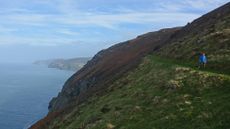The best hiking boots are arguably your most important outdoor equipment purchase. Hiking boots that feel genuinely comfortable and can cope with the terrain you are tackling will make even the most strenuous climb and rockiest descent seem perfectly serene... while poorly fitting and inappropriate footwear is uncomfortable and can cause blisters and even be downright dangerous.
This guide is all about helping you thread a path through the hundreds of options on the market, arriving at the best hiking boots for you, whatever your budget or the types of trails you plan on tackling. (Head to our best women's hiking boot guide for female-specific options). If you need durable footwear for walking your dog, a pair of the best men's walking shoes or best women's walking shoes will do just fine (or perhaps even some of the best wellies on wet days).
Best hiking boots to buy right now
Why you can trust T3 Our expert reviewers spend hours testing and comparing products and services so you can choose the best for you. Find out more about how we test.


If it's fast and light you're after, the Roclite G 345 GTX might be some of the best hiking boots for men right now. We're partial to a bit of tech at T3, and trail experts Inov-8 have an award-winning trick up their sleeve (or sock): a Graphene-infused sole unit. The wonder material adds strength, hardness and elasticity, resulting in up to 50% better wear – especially relevant for these deep 6mm lugs. It's not all marketing talk either, with these gracing the feet of athletes taking on some of the toughest outdoor challenges around, such as the UK's ultra-marathon Spine Race.
Designed for fast hiking, the grip is certainly phenomenal on wet rock and muddy grass alike, a fact aided by the highly flexible but shanked midsole. Weight is minimal, leaning into that trail running heritage, at 345g (size 8.5), you'll barely notice these on your feet – certainly until the miles really stack up. The bellows-style tongue is another trail-essential, keeping small stones and dust out of your boots, as is the low heel, allowing a full range of movement while providing more support than a standard shoe with the extra front lacing.
Read our full Inov-8 Roclite G 345 GTX review.
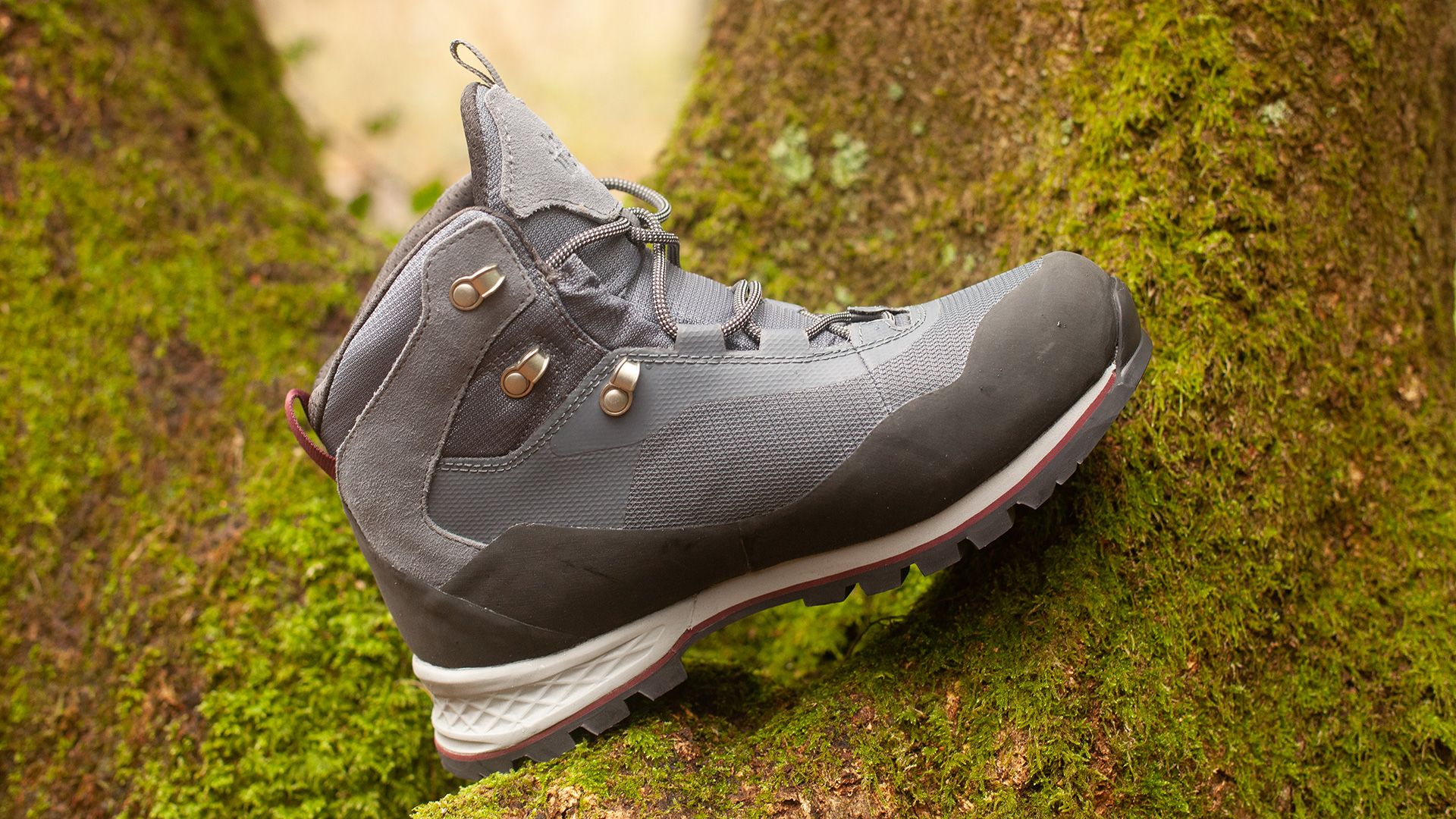

Designed with intrepid mountain hikers in mind, the Jack Wolfskin Wilderness Lite is our pick for the best hiking boot right now. A technical boot that's not stiff, heavy or bulky, these will cope comfortably with whatever you throw at them. Seriously grippy Vibram soles will keep you sure-footed even on tricky terrain, they're fully waterproof with Texapore technology, and a tough toe box and a high cut around the ankle provide further protection on uneven trails. They're comfy straight out of the box, too. While they're reasonably breathable and won't weigh you down on an all-day trek, we think the 'Lite' moniker is a bit of a stretch – there are lighter boots in our ranking if that's your priority.
Read our full Jack Wolfskin Wilderness Lite Texapore Mid review.


If you're looking for a versatile summer hiker, the Keen NXIS Evo Mid waterproof hiking boot is well worth a look. This lightweight men's hiking boot ticks a lot of boxes, offering plenty of comforts straight out of the box, a good grip and an excellent heel control system. With Keen’s own-brand waterproof membrane keeping the weather out, solid toe protection and 4mm multi-directional lugs for traction, there’s lots to keep you safe and warm on a long day out in the hills.
A stability shank might not be stiff enough for higher-level adventures, but it’s enough for casual rambles in comfort – a featherweight 332 grams per shoe certainly won’t tire you unnecessarily. Keen’s signature wide toe box is also present and correct, ensuring that the wide forefoot doesn’t get cramps or hotspots. Breathability is decent thanks to the mesh upper, and there’s an environmental nod in the PFC-free water repellent to boot.
Read our full Keen NXIS Evo Mid hiking boot review.
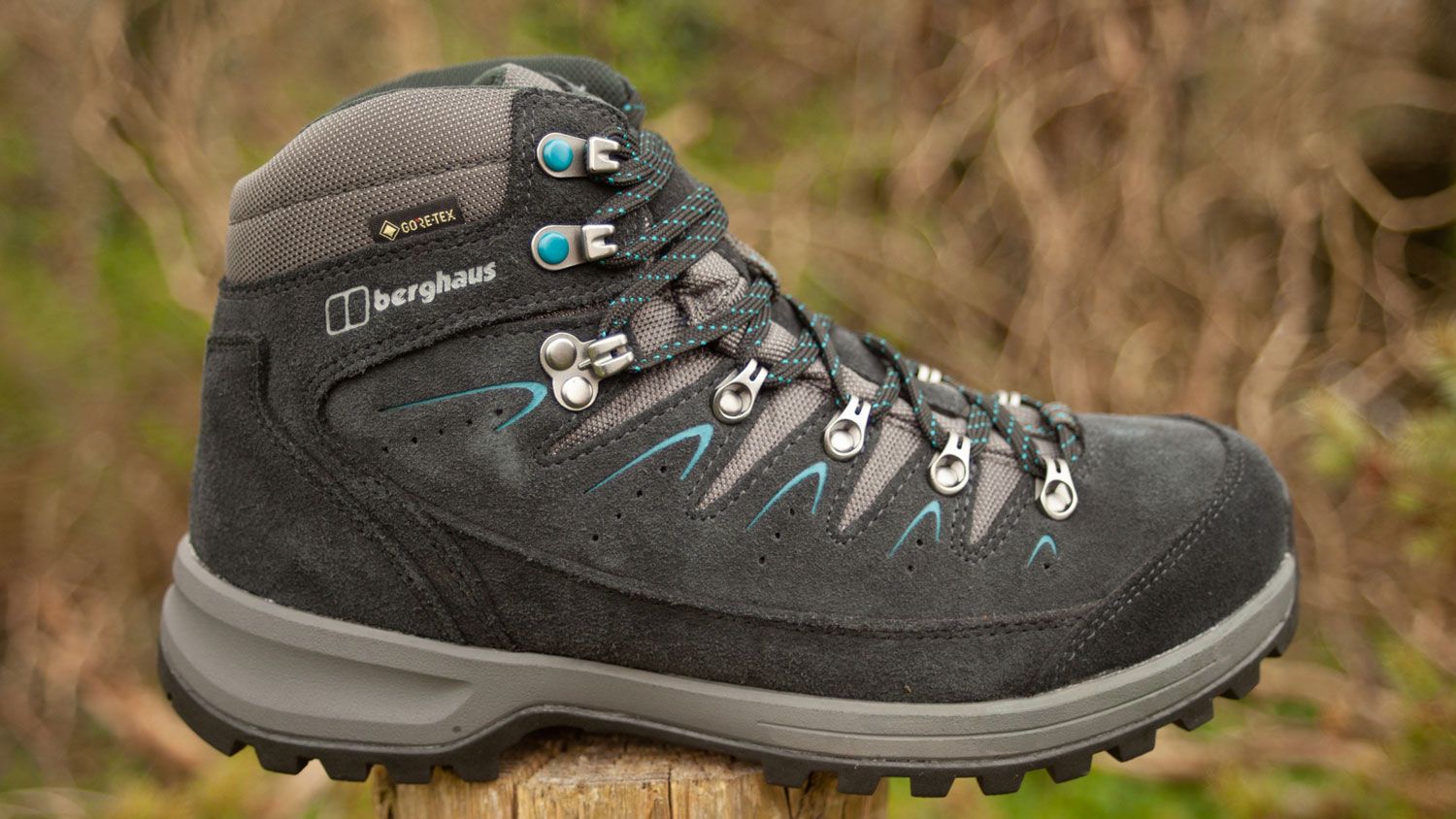

Another impressive all-rounder is the Berghaus Explorer Trek. This versatile design is perfect for those who are getting more ambitious with their hiking adventures and want to graduate from a more basic boot. We tested out the female version and found these boots delivered outstanding grip, even on wet rock or muddy ground, thanks to well-placed lugs. These boots are also ready to wear straight out of the box, with deep, cushiony insoles that mould to your feet over time. A robust suede upper with a Gore-Tex liner will keep your toes dry even in the worst weather. Note: we found these fit on the narrow side, especially around the toes.
Read our full Berghaus Explorer Trek review.
- Make sure you don't miss a deal by checking our Berghaus discount codes page before you buy

The Salomon Cross Hike 2 Mid-height boot combines lightweight running shoe comfort with the practical benefits of a hiking boot, including soles with deep, multi-directional lugs for grip, ankle support and Gore-Tex waterproofing. It’s a very easy boot to wear with a stitch-free upper construction and sockliner, as well as great underfoot cushioning.
The quick-lace system means the boots are easy to put on and take off, while you’ll enjoy all-day foot support. It’s worth noting this is footwear for spring, summer and autumn trail and hill hiking rather than for winter forays into the mountains. This is because the ankle support is only mid-height, and the soles are flexible. The grip would not be ideal for steep slopes, scree and snow. And our tester wants to ask Salomon why on earth they would include a feather grey colourway, as well as the black and bitter chocolate hues. The boots became dirty after just one muddy walk.
Read our full Salomon Cross Hike 2 Mid boots review.

The Taiss Light Mid GTX isn’t just a technical boot – these are also the lightest crampon-compatible mountaineering boots on the market. When it comes to weight, they even undercut featherweight rivals like the Arc’teryx Acrux LT and the Scarpa Ribelle Lite HD. Unbelievably light, precise and nimble, these extremely capable 4-season boots excel on technical terrain. And despite their lightweight build, they’re also decently robust, able to cope with abrasion from rock and ice.
However, they’re still a bit of a specialist boot, especially for UK winter use. In particular, their spartan feel underfoot, lack of insulation, and lower ankle cuff are all design features that mean they are not as warm, protective or well-cushioned as bigger, burlier boots. In those respects, there are probably better all-around B2s out there. However, if your priorities are flexibility, feel and precision, as well as the lowest weight possible, they’re the best out there right now.
Read our full Mammut Taiss Light Mid GTX review.
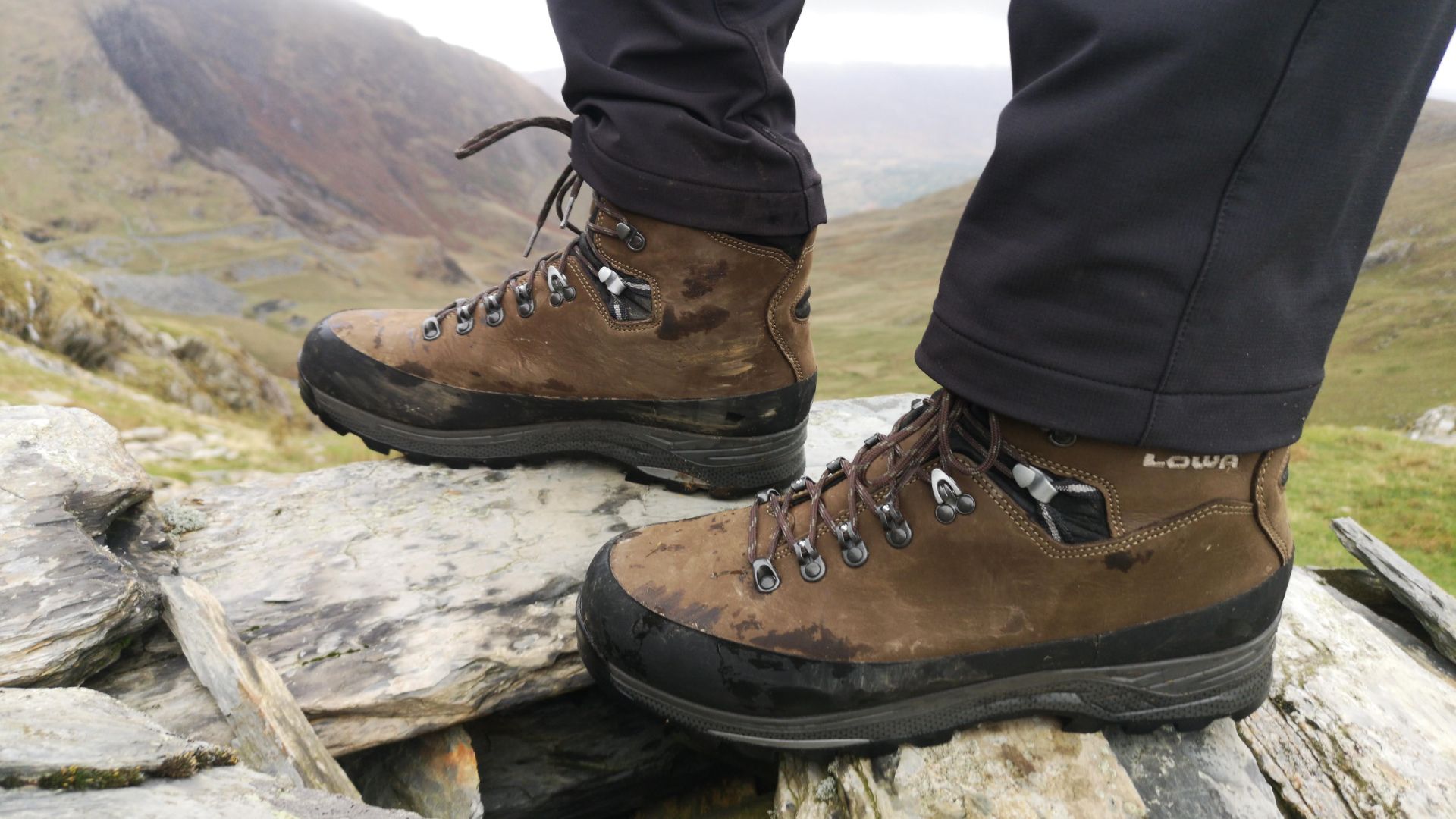
This is a high-volume boot with a roomy forefoot, even in the standard model – though there is a wide version of the Tibet, too, if you have very broad feet. The toebox offers plenty of room for toes to splay when walking, and they’re comfortable to wear all day. A generous rocker promotes a natural walking action, and the excellent dual-zone lacing system meant we could dial in a precise fit with no heel slip.
Surprisingly for an all-leather boot, we found the Tibet GTX needed next to no breaking-in. The latest model has a softer ankle cuff, too, with a bit more flex than the previous generation, which makes for easy, fuss-free walking from the get-go. On test, performance was very good on all but the most technical terrain. The Vibram outsole keeps feet well planted on rock, mud and grass. The nicely undercut heel brake makes it easy to dig in when going downhill.
All in all, it’s a great boot for high mileage days across mixed surfaces and feels both protective and stable. The latter quality is particularly noticeable if you’re carrying a heavy pack, which makes this a good choice for technical treks and demanding backpacking trips too.
Read our full Lowa Tibet GTX review.


The Acrux LT GTX is a modern climbing and mountaineering boot with excellent heel-to-toe rigidity, which can take a crampon. Primarily designed for three-season alpine conditions – balancing protection, technical capability and durability with remarkably low weight – the boot has a precise feel and delivers superb climbing performance, with or without a crampon fitted.
This boot’s stiffness makes it a very competent and capable performer on steep ground, enabling you to edge with confidence. The highly tapered toe is also an ideal shape for jamming into small rock pockets. The front climbing zone under the toe works well on a variety of different types of rock. It’s a great boot for technical climbing and scrambling. It works just as well with a crampon fitted for snow and ice too, which again is largely down to the boot’s stiffened midsole.
On test, we did discover some downsides, including minimal cushioning and a narrow fit, which won’t suit everyone (especially if you have wide feet or just prefer a roomy toe box). Also, the fabric uppers aren’t the warmest, and though the Gore-Tex lining provides a little insulation, you still need to guard against numb toes.
Read our full Arc’teryx Acrux LT GTX review.
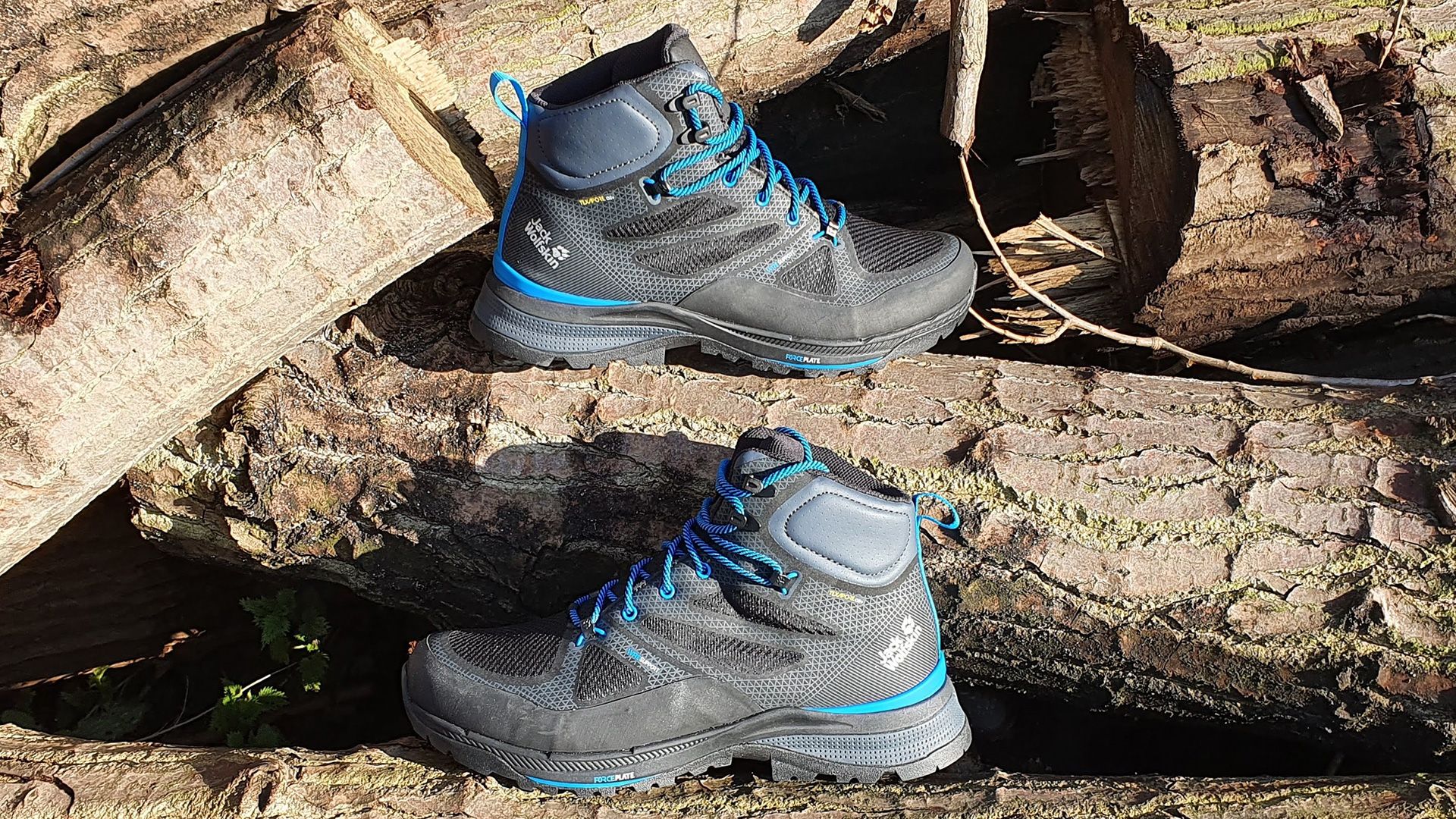

The Jack Wolfskin Force Striker Texapore boot is not a shy and retiring boot, it’s chunky in most dimensions and radiates the kind of knockabout robustness you’d hope for in a hiking companion. There are a few factors mixed into that impression - the high ankle and substantial padding offer serious support for tiring legs, while the forefoot ‘force plate’ hidden in the sole unit adds stiffness and protection all in one. This makes a relatively lightweight boot seem much more substantial - an ingenious trick. That said, the mesh and fabric upper does a great job of shedding weight while keeping things breathable, as does the Texapore o2 membrane.
Running through the boot is a solid seam of quality components too, which add little by little to a good overall impression - the alloy lace hooks, for example - and, of course, the all-important sole unit. That’s moulded from Vibram Megagrip, offering a fierce grip on uneven and rocky terrain. Overall, the Jack Wolfskin Force Striker Texapore boot has lots to say for itself and not much to complain about - a worthy competitor.
Read our full Jack Wolfskin Force Striker Texapore review.


The Inov-8 ROCFLY G390 is a new hiking boot for AW21 from UK-based Inov-8, and features the company’s acclaimed Graphene-Grip outsole. The Graphene isn’t just technology for the sake of it, adding durability and strength to a very grippy sole compound (Inov-8 claims a 50% improvement on strength and wear). Inov-8 has rigged the deck in their favour by adding 35 multi-directional 4mm deep lugs to the sole too, their distribution specifically designed to prevent debris from gumming them up.
The midsole also features Graphene, this time in the shape of G-Fly foam, its presence being a first for hiking boots. The knitted upper conforms to the foot, allowing the foot to swell over longer distances without requiring adjustment, as well as offering excellent breathability. Coming in at a stupidly lightweight 390g, the Inov-8 ROCFLY G390 has already been used to break distance and speed records, namely James Forrest’s new record time for a solo and self-supported hike of Great Britain’s National Three Peaks.
Read our full Inov-8 ROCFLY G390 hiking boot review.
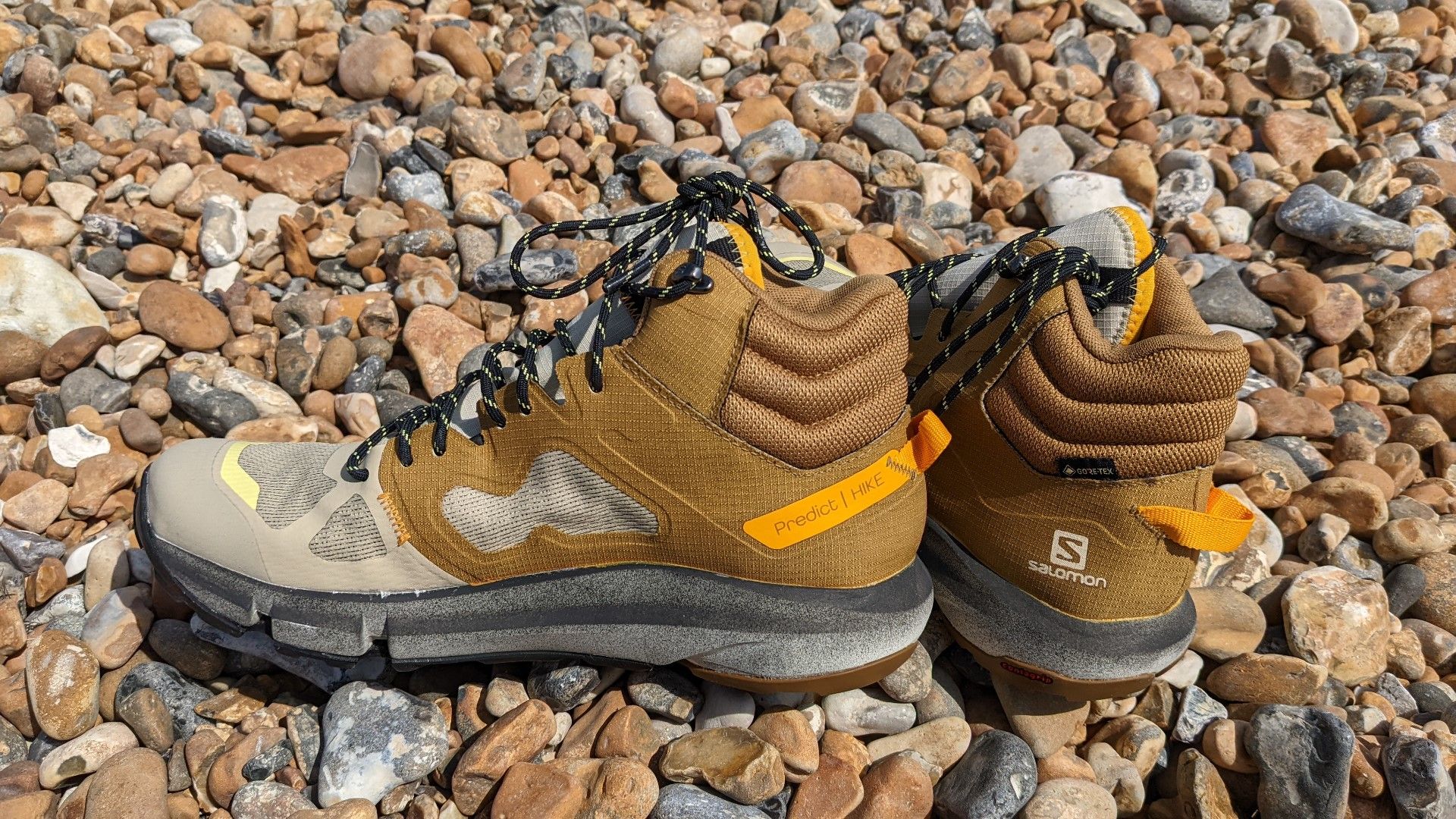

The Salomon Predict Hike Mid is a boot with plenty of bounce. In the manner of a Hoka One One model (although without the head-turning looks), these really do bounce you onwards with each stride, especially on harder surfaces. The sole unit is fairly still but flexes enough to contribute to the bouncy ride. The build quality is solid, with the mid-height cut delivering ankle support, and the Gore-Tex keeps rain at bay effectively.
The lacing system keeps everything securely in place, and although the laces can be slick, to begin with, they do bed in quickly. On the down-side, we found they came up narrow – if you've got wide feet, you might need to go a half or even full size bigger than normal. And while we didn't have this issue, some other customers reported debris getting stuck inside the layers of the boot.
Read our full Salomon Predict Hike Mid review.


The Keen Ridge Flex WP has the makings of a bit of a classic, combining the elements of several recognisable Keen boots into one, along with some new technology to boot. There’s the mid-ankle support and robust padding of the Keen Targhee on show here, as well as a proprietary waterproof membrane and similarly in-house sole unit. Environmentally preferred leather panels make up a sizeable percentage of the upper, adding plenty of foot protection and durability to the upper.
The new technology element is the Keen bellows system, which Keen claims reduce the amount of energy required to flex the sole on each step by 60%. The bellows section sits just above the toe box, allowing the upper to flex seamlessly and also avoiding the age-related cracking and damage that can occur in this high-use area. This also means less requirement to wear the boots in - the flex is already built in - making for a more comfortable boot even when box-fresh. It’s an ingenious concept and adds quite a few benefits to an otherwise stolid and robust boot; well worth considering for lower-level treks and longer day hikes.
Read our full Keen Ridge Flex WP hiking boot review.
How to choose the best hiking boots for you
The two key things to prioritise when hunting for the best hiking boot for you: finding the right boot style for the activity and getting a really good fit for your individual foot shape. The fit will vary by brand and style of boot, with some coming up much narrower (or broader) in the midfoot than others.
It's absolutely vital to try boots on before embarking on an expedition, and usually wearing them around the house before removing the retail labels is enough to show up any hotspots that could lead to painful difficulties further down the line. Head to our guide to how to break in hiking boots for some top tips (and our guide to how to treat blisters if the worst comes to the worst).
Although there are some stunning and super-technical hiking boots that might catch your eye, make sure you actually need the features they're offering before you shell out. Super-stiff mountain boots can be a trial on casual Sunday strolls, but equally, rocking up in trainers for a snowy ascent is a terrible idea. Generally, though, the extra support of a good hiking boot will see you happily meander wherever the fancy takes you.
The golden rule is to buy what fits and a model that suits your main use. In terms of brands, at the more robust end of the spectrum, La Sportiva, Scarpa, Mammut, Lowa and Aku all build boots that will shame a tank, while at the lighter, summery end, Teva, Keen and Salomon bring considerable expertise to the table.
FAQ
What are the most common hiking boot materials and technologies?
Construction-wise, old-school full leather hiking boots are rare beasts these days, not only because of cost but also because they need months of breaking in before extended use. Modern boots use a range of synthetic materials in addition to leather panels, so are much softer out of the box. Indeed, the latest thermo-fitted/NestFit models are pretty much ready to rock straight off the shop floor, although wearing them around the house or to and from work is still a good idea before leaving on a major expedition.
Outdoor tech has come a long way in recent years, with huge strides being made in the way the best hiking boots are designed and built, from tech geared to keeping your toes warm in sub-zero conditions to innovations that help you stay upright on the most treacherous and slippery trails. Some of the most useful technologies and features include Vibram Megagrip (enhanced traction), Gore-tex (improved waterproofing), NestFit (bio-mapping for comfort), Thermo Tech Application technology (better support), and CleanSport NXT (odour control).
Do I need specific boots for hiking?
Most modern hiking boots include a waterproof membrane, which will be useful when you head off the beaten track. In addition, hiking and mountain boots often incorporate a raised 'rand', a rubber buffer over the leather of the boot nearest the sole, which protects the boot from sharp stone cuts when walking across scree (small loose stones that sometimes cover slopes).
Hiking boot soles will also be much stiffer than street shoes/boots to shrug off rough surfaces, incorporating aggressive tread for better grip on wet grass, moss or mud and often cleverly-placed sticky rubber areas for extra grip on wet rock. That stiffer sole gets a grade from B0 to B3-B0 and below, making them fine for casual summer hikes but too flexible for crampons. Meanwhile, B1-3 boots offer increasing levels of stiffness to accommodate increasingly technical rigid crampon use.
This might sound excessive for the causal walker, but if you’re hill walking in the UK winter, opting for a stiffer crampon-compatible walking boot is highly recommended, as conditions can change fast. A lighter-weight alternative is a walking shoe. Check out our walking boots vs walking shoes explainer if you're deciding between the two.
What hiking boot features do I need?
In a nutshell, you're looking for boots that are luxuriously comfortable, unstintingly waterproof, heroically breathable, tank-like in their ruggedness, and offer as much grip as Spider-Man's socks. It’s essential to get the right rating for your hiking boot – wearing B3 double-boots for summer trekking will be hell, as will attempting the likes of Indicator Wall in Converse. Overall, you’re looking for ankle support from a boot – which in the hills can be vital when a stone shifts underfoot – but also a comfortable fit.
A snug (not tight) fit minimises heel lift, as well as assorted blisters at ‘hot spots’ like heels and toes (although we'd always recommend a pair of the best hiking socks for an added layer of protection). When seeking out winter boots (B1+), this is particularly important, as a loose fit will see your toes smash into the toe box when using crampons, and the stiffer sole will also exaggerate heel lift unless the heel pocket fits just right.
The accepted wisdom is to try on hiking boots in the afternoons, once your feet have expanded, and take a range of socks to try them on with. Thin office socks are helpful to show up any obvious shape mismatches and pressure points before moving on to your preferred walking sock. Do experiment with sock-fit as well as boot fit, as even the most expensive socks are cheap compared to boots, and some of the more specialised socks can make a real difference to your hiking comfort.






